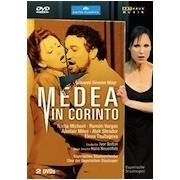The German-born composer Johann Simon Mayr–later to Italianize his name in his adopted homeland–is now best known as Donizetti’s teacher. To the bel canto he added rich orchestration and a type of classicism; during the first two decades of the 19th century his operas were performed in many Italian cities as well as in Germany, London, St. Petersburg, and New York. He was held in such high esteem that when he died in 1845, Verdi offered a eulogy. His most famous work is Medea in Corinto, which has been recorded three times commercially (and is available as a “pirate” as well), but this is its first video presentation.
The opera itself is somewhat problematic–it contains long arias and stretches of recitative whose classicism can seem stilted and hold up the drama, and Mayr seems unable to actually present ugly situations in music; but there is a fair amount of exciting music and stirring arias as well.
This performance comes from Munich and was recorded in 2010. The production, designed by Anna Viebrock and directed by Hans Neuenfels, is controversial and will not be to everyone’s taste. Dress is modern, for the most part, although Creon wears a frock coat out of Dickens, and for some reason he is made out to be a limping hunchback. There is violence galore, with men invariably carrying guns or knives; people are tortured and murdered willy-nilly, throats slit. Dead animals are dragged onto the scene.
Silent figures representing Hymen and Amor roam the stage; the latter (an adult dressed in white, with silver wings), after a bitter duet between Giasone and Medea, stabs himself in the genitals. The set is a two tier house of sorts (with a third, gabled floor); the main, stage floor houses most of the action, the second is outfitted as an office/living room/war room.
Medea first appears dressed as a witch doctor: grass skirt, trinkets and shells around her neck, and a mask; she’s clearly an outsider. But she strips down to a black slip soon enough and remains half-clad until after the murder of her children, when she re-appears in white. Neuenfels is obviously attempting to help us side with Medea as a wronged woman in a violent society who has stripped herself bare (in a way) in order to belong, but who is rejected nonetheless. Creusa, the innocent victim of Medea, is portrayed as a nasty bitch, cold and overdressed. The music tells a different story, and Creusa’s tunes are lovely (her last-act aria is accompanied by a harp!) while her behavior says something else. It does not work as such.
All that having been said, it’s hard to be bored during this gore-fest, and there’s plenty of action in what Neuenfels has tried to turn into a timeless, timely political and emotional thriller. And luckily, he also has directed the singers well and has a fine singing actress in the title role. Nadja Michael, a well-known Salome, sings the big, emotional roller-coaster title role with power in all ranges, with absolute conviction, and a good enough handle on the coloratura.
I recall an old recording on the Vanguard label (perhaps from the 1970s?) starring the little-appreciated soprano Marisa Galvany, who whips up a frenzy as Medea and interpolates high Ds and E-flats galore, each of which serves a thrilling dramatic purpose: one suspects that the role’s creator, Isabella Colbran, might have done the same. Michael does not have these notes, but she is quite fine.
Ramon Vargas, in soldier’s uniform and recently slimmed down, is an impressive Giasone, using the dark lower part of his voice to good effect. Another tenor, Alek Shrader, sings Egeo, who was betrothed to Creusa; his vocal line is higher and more florid and he handles it well. Alastair Miles is a mean old Creon, and Elena Tsallagova a lovely Creusa–vocally, though, she is made to act like a spoiled housewife-of-Corinth.
Ivor Bolton, a Baroque specialist, gets both the opera’s classicism and bel canto traditions; the fact that he can’t turn the work into a masterpiece isn’t his fault. The Munich forces play and sing superbly. Picture and sound are first rate, and there are subtitles in all major European languages as well as Chinese and Korean. Bonus features include a mini-documentary on Mayr and a backstage look as well as interviews. None of this extra material is riveting. Recommended, with reservations about the production.
































